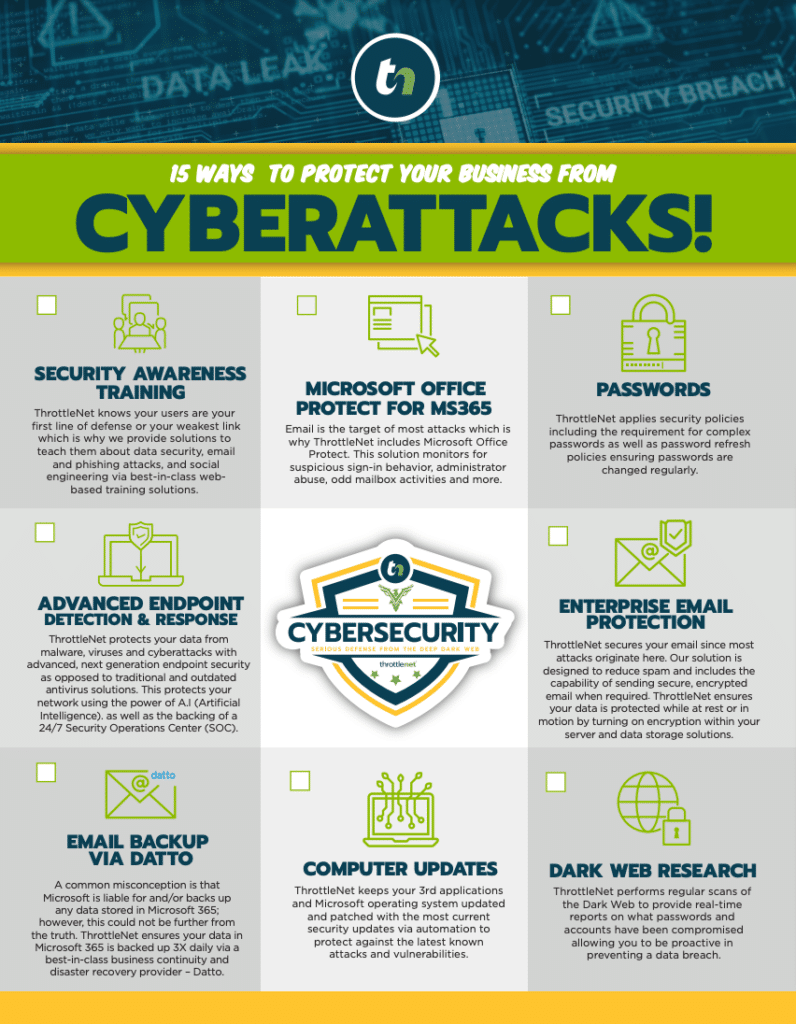Mobile Device Security for Business: Protecting Your Company Data
Are your company’s mobile devices truly secure?
Do employees download apps that might put your business or client information at risk?
These are questions every organization should be asking in today’s mobile-first workplace. As smartphones and tablets become essential tools for communication, collaboration, and remote work, mobile device security for business is more critical than ever.
Aaron Oliver, Senior Network Infrastructure Engineer at ThrottleNet, appeared on TNtv to discuss how organizations can protect sensitive data while still enabling mobility and productivity.
Understanding Mobile Device Security Risks
Oliver explained that mobile devices—whether company-owned or personally owned—can be significant security vulnerabilities when not properly managed.
A prime example, he said, is the controversy surrounding the Facebook Messenger app, which sparked widespread concern about privacy and data access. Many users feared that Messenger could record audio, access photos, and collect contacts without their knowledge.
While Oliver noted that much of this fear may have been exaggerated, the example highlights an important truth: mobile apps often request permissions that can expose personal and corporate data.
Every time an employee downloads an app that tracks location, accesses contacts, or enables phone dialing, they’re extending a degree of trust to that application and its developer. For business owners, that trust needs to be managed carefully.
Why Mobile Device Security for Business Matters
Today, employees rely on mobile devices for everything—email, messaging, document access, video conferencing, and client communication. Many of these devices connect directly to company networks or store sensitive customer information.
Without proper safeguards, a single compromised device can lead to:
- Data breaches that expose client or financial data
- Regulatory violations under HIPAA, FINRA, or GDPR
- Unauthorized access to cloud platforms or business systems
- Reputational damage that erodes client trust
Oliver emphasized that mobile device security for business isn’t just about preventing viruses—it’s about protecting every piece of data your team carries in their pockets.
Understanding App Permissions and Risks
Most users never read the full terms or permissions list when downloading apps. Yet these permissions often include access to critical data points—like location tracking, contact lists, or even microphone usage.
Oliver cautions that users should take a few minutes to review what each app is allowed to do. “You’re essentially giving that developer a key to certain parts of your phone,” he explained.
Apple vs. Android App Stores
- Apple App Store: Most iOS apps are heavily vetted before approval, offering a higher baseline of trust. However, users should still review permissions before installation.
- Android Platforms: Android apps can come from multiple stores and even independent developers. This flexibility creates more options—but also more risk. Users must ensure apps come from verified, trustworthy sources before installing them.
When it comes to mobile device security for business, Android environments require especially strong policies and oversight to prevent risky app installations.
The Business Impact of Unsecured Devices
Oliver pointed out that business owners often overlook the hidden risks of allowing employees to download any app they want—especially when those devices contain company or client data.
If your organization operates under regulatory standards like HIPAA (healthcare) or FINRA (financial services), even one unapproved app could create compliance violations.
Beyond regulatory concerns, unsecured mobile devices can also lead to:
- Data leakage: Personal apps accessing corporate files or email.
- Phishing and malware attacks: Malicious apps designed to steal credentials.
- Network compromise: Infected devices connecting to company Wi-Fi.
- Lost or stolen devices: Exposing sensitive client communications or login credentials.
The solution? A centralized mobile security policy that gives your business control over what employees can download, access, and share.

How to Prevent Mobile Security Threats in the Workplace
Oliver recommends a multi-layered approach to protect mobile devices in any business environment.
1. Create a Written Mobile Device Policy
Every organization should have a documented policy outlining:
- Which devices are approved for company use
- What apps or app categories are restricted
- How data should be stored, accessed, and transmitted
- Procedures for lost or stolen devices
This policy should apply to both company-issued and BYOD (Bring Your Own Device) setups. Clear expectations reduce ambiguity and help employees understand their role in maintaining security.
2. Implement Mobile Device Management (MDM) Software
For companies handling sensitive or regulated information, Oliver recommends deploying a centralized mobile management system.
An MDM solution allows IT administrators to:
- Enforce password and encryption standards
- Manage app permissions remotely
- Push security updates automatically
- Wipe or lock lost devices instantly
- Control which apps can be installed
For HIPAA- or FINRA-compliant organizations, this level of control is critical. MDM platforms also make it easy to push software updates or new configurations to every device simultaneously—improving both convenience and security.
3. Educate Employees About Mobile Security
The human element remains the weakest link in cybersecurity.
Oliver stresses that businesses should train employees to recognize app permissions, phishing attempts, and suspicious downloads.
Key training topics include:
- Identifying safe vs. unsafe app sources
- Recognizing fake or copycat apps
- Understanding the risks of connecting to public Wi-Fi
- Setting strong passcodes and enabling biometric security
When employees understand their responsibility, your entire organization becomes more resilient.
4. Regularly Audit Devices and Permissions
Mobile device security isn’t a one-time task—it’s an ongoing process.
Oliver advises businesses to conduct regular security audits to review:
- What apps are installed on corporate devices
- Whether devices are encrypted and up to date
- If any new permissions have been granted since the last review
Proactive monitoring helps detect and address problems before they escalate into data breaches.
The Future of Mobile Device Security for Business
As mobile technology continues to evolve, so do the threats. From AI-powered phishing scams to hidden malware in legitimate-looking apps, cybercriminals are becoming more sophisticated.
Businesses that invest in proactive mobile security now will be better positioned to handle tomorrow’s challenges—whether that means securing remote workforces, integrating IoT devices, or meeting new data privacy regulations.
Oliver’s advice is simple: “Security isn’t a one-time project—it’s a continuous mindset. Every app, every device, every download matters.”
Strengthen Your Business with ThrottleNet Mobile Security
Your employees rely on their phones and tablets every day to keep your business running—but that convenience shouldn’t come at the cost of security.
ThrottleNet’s team, led by Aaron Oliver, helps organizations develop robust mobile device security for business programs that protect sensitive information, ensure compliance, and keep your operations running smoothly.
To learn more about securing your company’s mobile devices, contact ThrottleNet at (866) 730-3136 or visit www.throttlenet.com.
Protect your business from mobile threats—because one unsecured device can put everything at risk.



